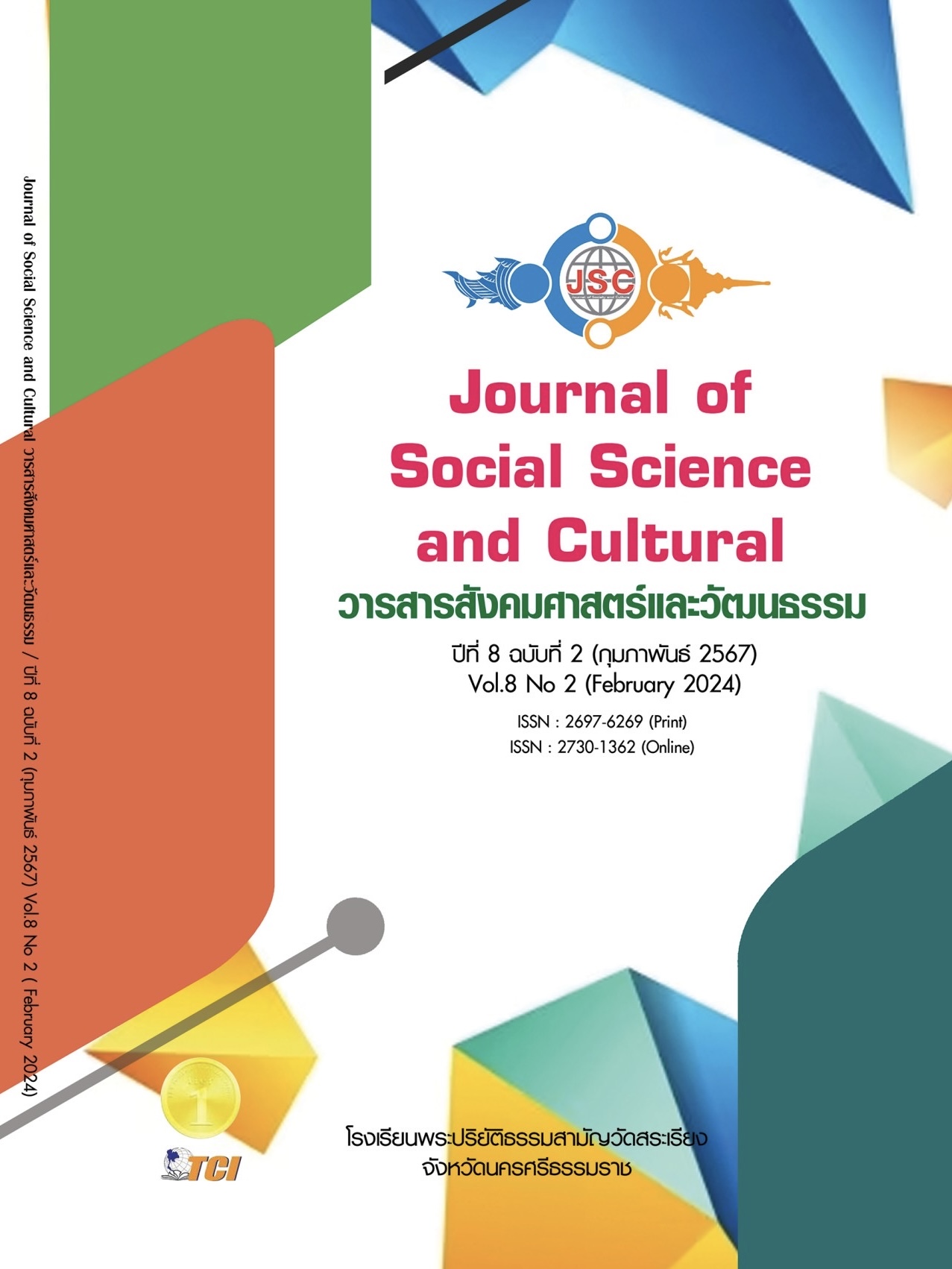THE DEVELOPMENT OF A PARTICIPATION VILLAGE MODEL FOR BEHAVIOR MODIFICATION TO REDUCE CHRONIC NON-COMMUNICABLE DISEASE WITH PIHW MODEL 2022
Main Article Content
Abstract
The objective of this research was to development a village to modify the behavior to reduce chronic non-communicable disease with a participative with PIHW Model 2022. The research procedure was 1). Finding and analyzing the community health problems 2). Developing Model for reduce chronic non-communicable disease with a participation 3) Implementation. The information was received from the representative older than 15 years, selected 106 samples. The research tools were the evaluating form in health and health knowledge part on 3E 2S. That performed by Health Education Division (2022). The reliability was 0.82, Data were analyzed by content analysis. The results revealed that 1) The community health problems: The hypertensive patient was first. The population take risks by non-healthy foods. 2) A model for reduce chronic non-communicable disease with a participation was composed of: 2.1) set needs and goals 2.2) Developing leaders for screening skills on Ping-Pong 7 colors Model. 2.3) the community network operations on promotion health knowledge 2.4) communication network 2.5) environment designs for health literacy facilitated; 2.6) setting the behavior modify awareness in family; 2.7) results: the population had health literacy on 3E 2S and improved health status. 3) The implementation results that; the population improved health literacy, significant p<0.001, improved the health behavior modifying, significant (P<0.001).
Article Details
References
กรมควบคุมโรค กระทรวงสาธารณสุข. (2561). แผนพัฒนาด้านการป้องกันควบคุมโรค และภัยสุขภาพของประเทศ ระยะ 20 ปี (พ.ศ. 2560 - 2579). กรุงเทพมหานคร: สำนักพิมพ์อักษรกราฟฟิคแอนด์ดีไซน์.
กองสุขศึกษา กรมสนับสนุนบริการสุขภาพ. (2565). คู่มือการดำเนินงานสุขศึกษาหมู่บ้านปรับเปลี่ยนพฤติกรรมสุขภาพ. เรียกใช้เมื่อ 10 กรกฎาคม 2565 จาก http://hed.go.th/linkHed/396
คณะพยาบาลศาสตร์. (2565). แนวทางการบูรณาการ สบช.โมเดลในการออกแบบการจัดการเรียนการสอนและกิจกรรมเสริมหลักสูตร. นนทบุรี: สถาบันพระบรมราชชนก.
นงลักษณ์ ตุ่นแก้ว และคณะ. (2561). ผลของโปรแกรมปรับเปลี่ยนพฤติกรรมสุขภาพตามแนวทาง3อ.2ส.1ย. และการใช้ปิงปองจราจรชีวิต 7 สี ต่อความรู้ พฤติกรรมสุขภาพ และระดับน้ำตาลในเลือดของผู้ป่วยเบาหวาน. วารสารสมาคมพยาบาลแห่งประเทศไทยฯ สาขาภาคเหนือ, 24(2), 83-95.
นาตยา เกรียงชยพฤกษ์. (2560). การศึกษากระบวนการดำเนินงานพัฒนาหมู่บ้านปรับเปลี่ยนพฤติกรรมลดโรคมะเร็งโรคความดันโลหิตสูงโรคหัวใจและหลอดเลือด:กรณีศึกษาจังหวัดตรัง. วารสารคณะพละศึกษา, 14(1), 28-38.
พิมพ์ใจ อุ่นบ้านและคณะ. (2564). ผลของโปรแกรมการจัดการตนเองต่อพฤติกรรมการดูแลตนเองและการควบคุมความดันโลหิตของผู้ป่วยความดันโลหิตสูงที่ควบคุมไม่ได้. วารสารวิทยาลัยพยาบาลบรมราชชนนี อุตรดิตถ์, 13(2), 59-72.
โรงพยาบาลส่งเสริมสุขภาพตำบลบ้านแม่ผาแหน. (2564). รายงานทะเบียนกลุ่มเสี่ยงโรคหลอดเลือดสมอง. เชียงใหม่: โรงพยาบาลส่งเสริมสุขภาพตำบลบ้านแม่ผาแหน.
ลัดดาวัลย์ ไวยสุระสิงห์. (2563). กระบวนการพยาบาลชุมชน : แนวคิด ทฤษฎี และการประยุกต์ใช้ดูแลสุขภาพประชาชน. กรุงเทพมหานคร: สำนักพิมพ์แห่งจุฬาลงกรณ์มหาวิทยาลัย.
ศิริเนตร สุขดี. (2560). การพัฒนารูปแบบการปรับเปลี่ยนพฤติกรรมสุขภาพของกลุ่มเสี่ยงโรคไม่ติดต่อเรื้อรังด้วยการมีส่วนร่วมของชุมชน. ใน ดุษฎีนิพนธ์ปรัชญาดุษฎีบัณฑิต สาขาวิชาการวิจัยพฤติกรรมศาสตร์ประยุกต์. มหาวิทยาลัยศรีนครินทรวิโรฒ.
สถาบันวิจัยประชากรและสังคม มหาวิทยาลัยมหิดล (วปส.). (2565). สุขภาพคนไทย 2566. (พิมพ์ครั้งที่ 1). กรุงเทพมหานคร: อมรินทร์พรินติ้งแอนด์พับลิชชิ่ง จำกัด (มหาชน).


